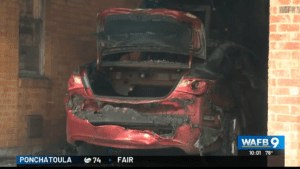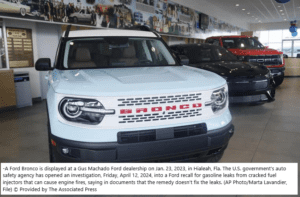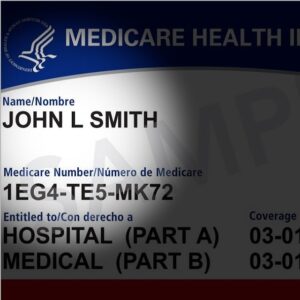FMVSS Exemption Considerations for Fully Autonomous Vehicles
Summary: The human role in FMVSS should not be removed for exemption request because there is no driver. Rather, what should be stated is how the driver is being replaced in that safety role as a matter of system design.
These comments were filed regarding the General Motors Petition for Temporary Exemption from FMVSS — Federal Motor Vehicle Safety Standards (https://www.regulations.gov/document/NHTSA-2022-0067-0002) However, they are likely to apply to any autonomous vehicle that does not have conventional driver controls or operates in a mode which does not have an officially designated driver.
It is good
to see companies working to advance the potential benefits of autonomous vehicle
technology. However, it is also important for NHTSA to ensure public safety
when such technology is deployed on public roads.
There will
almost certainly need to be an auxiliary controller to command motion of
vehicles without normally accessible driver controls. To the extent that these
are in-vehicle wired controls the question arises as to their suitability for
safe vehicle control (e.g., using a “Playstation” type video game
controller) and whether they can be improperly activated during autonomous
operation. To the extent that these are wirelessly connected controls there are
serious security issues that must be considered. In the absence of normal
driver controls any petitioner should be required to justify the safety and
security of its maintenance and supplemental human-operated vehicle control
strategy beyond more general claims of working on cybersecurity.
FMVSS
101: Petitioner
should demonstrate that all telltales that are intended to prompt human driver
reaction similarly prompt a relevant ADS reaction to an indicated exceptional
condition. If no such demonstration is provided, NHTSA
would simply be taking Petitioner’s word that the telltale functions are
implemented in a way that provides equivalent safety. (This also applies to
other telltales such as FMVSS No. 126, 138, etc.)
FMVSS
102: While the ADS
is said to control the transmission, there will be times in which humans need
to know the state of the transmission for safety, especially whether the
vehicle is in park or not. This includes emergency responders and maintenance
personnel to ensure that the vehicle will not move unexpectedly when it is
operating in a degraded or post-crash state. NHTSA should evaluate the
suitability of a passenger video display for reliably displaying vehicle park
state to non-passenger stakeholders.
FMVSS
104: From the
NTHSA summary: “For GM’s petition
for exemption from portions of FMVSS No. 104, GM argues that the purpose and
intent of the safety standard is obviated by the Origin’s sensor system design.” GM’s argument is ridiculous from a technical
point of view. (Their technical
disclosure is more substantive, but this type of lawyer argument in their
summary serves to undermine their filing’s credibility.) In the context of an ADS, the intent of the
safety standard is not to permit a human driver’s eyes to see out the
windshield. Rather, it is to ensure that all visual sensors can see through the
windshield (if interior mounted), or through their lenses and weather covers as
appropriate. It is completely foreseeable that camera and lidar operation will
be impaired by adverse operational conditions. Moreover, the problem is likely
to be worse than for human drivers because even a relatively small bug splat on
a camera lens will form a visual obstruction covering a much larger fraction of
the field of view compared to the same bug impacting the windshield of a
human-driven vehicle, because human drivers can and do simply move their heads
a bit to see past windshield obstructions.
GM states that it keeps its sensors clean, but provides no objective way
for NHTSA to validate the claim.
FMVSS
111: From the
NHTSA summary: “GM points out that the purpose and intent of FMVSS No. 111
is based on human perception and visibility so there is no operational safety
need for these requirements when applied to a vehicle driven by an ADS.” This
argument amounts to the common fallacy of: “humans have limitations and
therefore computers will be perfect.” (Anyone paying attention knows that
computers fail, often spectacularly – just in different ways than humans.) There
are safety requirements behind FMVSS 111 that are not about “human
perception and visibility” but rather, for example, not running over
children that are not visible to the driver sensors. Again, GM’s lawyer-phrased argument
undermines the credibility of their filing. In addressing this request for
exemption the petitioner should explain why it is the case that small children
will be protected from being run over at least as well as by a human driver using
a rear view camera as one example. Again, the technical substance is better,
but leaves a big open question. GM provides pictures indicating that cameras
can potentially see areas required. However, there is no data supporting that
those cameras will correctly sense and classify children close to the vehicle
with high accuracy, especially at night when the vehicle automation might rely
more heavily on roof-top mounted lidar sensors. The safety requirement is not
camera visibility, but rather that the driver+camera will avoid hitting
children. Given apparent issues with camera-based AEB systems having trouble
sensing and avoiding hitting children this is an issue that needs to be taken
seriously.
FMVSS
201: From the
NHTSA summary: “GM argues that sun visors are not necessary because the
Origin is not operated by a human driver, and the ADS does not use the
windshield for visibility.” Again, limitations of human drivers are not
the real point for ADS safety. It is well known that cameras struggle when looking
into the sun. GM should explain how they handle that problem (sun visors are a
way human drivers can handle it) and now NHTSA can validate that sun glare is
handled safely. GM states it is not a
problem for this system, hinting that perhaps they rely on lidar+radar instead
of a camera in such situations, but that raises additional concerns. GM should
provide a way for NHTSA to validate that sun glare does not present undue risk.
Validation: For all requested exemptions it is
not enough to simply say more or less “trust us, we have figured this
out” for an ADS equipped vehicle than it is for a conventional vehicle. If
“trust us” were enough, there would be no need for the carefully
design tests in FMVSS for any vehicle. Rather, petitioners should explain (a)
why the broader safety objective of the FMVSS element being waived is still
being met (e.g., not hitting children vs. field of view), and (b) a way that
NHTSA can validate for itself that the safety objective is in fact being met. See: Koopman, “How to keep self-driving cars safe
when no one is watching for dashboard warning lights,” The Hill, June
30, 2018. https://thehill.com/opinion/technology/394945-how-to-keep-self-driving-cars-safe-when-no-one-is-watching-for-dashboard/
Regarding
Public Interest Considerations:
Safety Benefit: It is essential to keep in mind
when evaluating ADS petitions that potential safety benefits are purely
aspirational. There is not yet any proof that ADS-equipped vehicles will be
even as safe as a comparable active-safety-equipped human-driven vehicle using
any currently available or near term deployable technology. While supporting
the development of technology that has the potential to reduce harm is
laudable, this should not be done at the cost of increased near-term harm.
Putting road users at increased risk today because someday, maybe, perhaps,
autonomous vehicles might be safer is unacceptable. NHTSA should be in the
safety business, not the hopium business. That means exemptions should require
a concrete justification of deployed safety that is not weakened by promises of
ADS perhaps increasing safety in the future.
Environmental
Impact: Requiring
environmental impact data reporting is an excellent idea. It is important to be
mindful of indirect environmental and safety consequences of ADS-equipped
vehicle adoption. One example is that (presumably) decreased cost per mile is
prone to increasing demand, resulting in a potential increase in overall
emissions if small ADS-equipped vehicles are used for more trips. Both human harm and environmental damage
could be increased if ADS-equipped vehicles draw passenger loads away from mass
transit even if the total number of user-miles across all modes remains the
same. Moreover, use of uncrewed ADS-equipped vehicles can increase both total
pedestrian harm and emissions as well as road congestion if that leads to a
large increase in on-demand delivery services.
Equity: As NHTSA notes in their summary,
petitioners for exemptions extoll the potential benefits to expand
transportation options to under-served areas and customers with disabilities.
It is important to point out that these populations can be served with
traditional human-operated vehicles as well, so this is not a fundamentally new
capability, but rather an argument that cheaper costs will increase vehicle
availability (perhaps at the cost of increased road congestion). Note that
vehicle sharing does not require autonomy, nor does use of electric vehicles. To
the extent that the exemptions are for “robo-taxi” and shuttle type
applications, petitioners should not only say that their technology might
possibly help disadvantaged populations, but also how they plan to serve such
populations directly as a result of the exemption. Promising to serve such
populations in an exemption petition but then fielding a single token
wheelchair-accessible vehicle or only deploying in a rich urban center would
result in such statements of providing equitable transportation being only
aspirational rather than directly related to the exemption decision. Credit
should not be given for empty promises in evaluating an application.
Safety: While considering economic impacts
might be relevant as NHTSA notes in their summary, it is essential to remind
all stakeholders that the “S” in NHTSA stands for “Safety.”
It is imperative that economic motivations not over-ride the NHTSA mission to
ensure safety. Safety must come first, and not be overwhelmed by economic
pressure.
Standards: Petitioners who want exemptions
from FMVSS provisions should have an alternate method of ensuring that a
rigorous engineering approach has been used to ensure safety. Such an approach
was proposed by NHTSA itself in an ANRPM (Docket No. NHTSA-2020-0106 / RIN
2127-AM15 Framework for Automated Driving System Safety https://www.regulations.gov/docket/NHTSA-2020-0106 ). NHTSA should respond to
comments from that ANPRM and work further on setting up such a framework that
could provide and an alternate basis for ADS-equipped vehicle regulation.
SMS: NHTSA should require all
petitioners to implement an effective Safety Management System (SMS) as a
condition of receiving an exemption, with SMS data included in periodic reports
for the life of any vehicle.
Crash
Reporting: NHTSA
should continue to require crash reporting as proposed. The definition of a
crash should be scoped to include: (a) any contact between the vehicle and
another road user regardless of severity; (b) any contact between the vehicle
and other obstacles or infrastructure regardless of severity; (c) any
“near hit” that required evasive action from another road users
(e.g., pedestrian jumping back on sidewalk to avoid being hit while in a
crosswalk); (d) any substantive moving violation (e.g., running a red
light). Any responsible tester/operator
of an ADS will have data already compiled on all these events as part of their
SMS to ensure that they are operating safely on public roads, so the reporting
burden should be minimal. These reports
should be required for the life of any exempt vehicle.
Commenter
Qualifications: Prof.
Philip Koopman is an internationally recognized expert on Autonomous Vehicle
(AV) safety whose work in that area spans over 25 years. He is also actively
involved with AV policy and standards as well as more general embedded system
design and software quality. His pioneering research work includes software
robustness testing and run time monitoring of autonomous systems to identify
how they break and how to fix them. He has extensive experience in software
safety and software quality across numerous transportation, industrial, and
defense application domains including conventional automotive software and
hardware systems. He was the principal technical contributor to the UL 4600
standard for autonomous system safety issued in 2020. He is a faculty member of
the Carnegie Mellon University ECE department where he teaches software skills
for mission-critical systems. In 2018 he was awarded the highly selective
IEEE-SSIT Carl Barus Award for outstanding service in the public interest for
his work in promoting automotive computer-based system safety. In 2022 he was
named to the National Safety Council’s Mobility Safety Advisory Group. He is
the author of the book How Safe is Safe Enough: measuring and predicting
autonomous vehicle safety (2022). https://users.ece.cmu.edu/~koopman/







